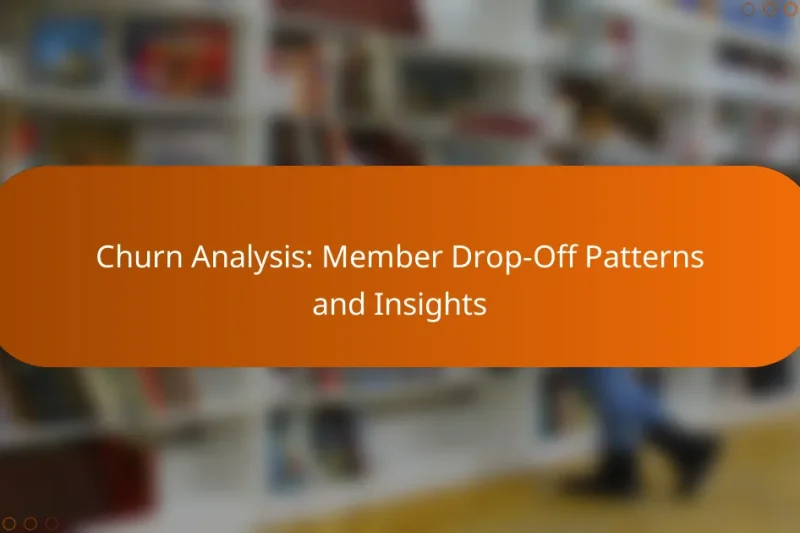Churn analysis plays a crucial role in enhancing subscription retention by uncovering patterns in member drop-off … Churn Analysis: Member Drop-Off Patterns and InsightsRead more
Subscription Membership Member Retention
In the competitive landscape of subscription businesses, member retention is crucial for long-term success. By implementing targeted strategies such as personalized communication and community-building initiatives, organizations can foster loyalty and engagement among their members. Additionally, measuring key metrics like churn rate and member lifetime value can provide valuable insights into the effectiveness of retention efforts.
Re-engaging Lapsed Members: Best Practices and Community Strategies
Re-engaging lapsed members requires a strategic approach that emphasizes personalized communication and value-driven incentives. By understanding … Re-engaging Lapsed Members: Best Practices and Community StrategiesRead more
How can subscription businesses improve member retention?
Subscription businesses can enhance member retention by implementing targeted strategies that foster loyalty and engagement. Key methods include personalized communication, loyalty programs, regular content engagement, feedback mechanisms, and community-building initiatives.
Personalized communication strategies
Personalized communication is crucial for retaining members in subscription services. Tailoring messages based on user behavior, preferences, and demographics can significantly increase engagement rates. For example, sending personalized emails with product recommendations or exclusive offers can make members feel valued.
Utilizing data analytics tools to segment your audience allows for more effective communication. Consider implementing automated messaging systems that adapt to user interactions, ensuring timely and relevant outreach.
Loyalty programs and rewards
Loyalty programs incentivize members to stay subscribed by offering rewards for continued engagement. These can include discounts, exclusive content, or points that can be redeemed for products or services. A well-structured loyalty program can increase customer lifetime value significantly.
When designing a loyalty program, ensure that the rewards are attainable and appealing. For instance, a tiered system where members unlock greater benefits as they engage more can motivate them to remain active subscribers.
Regular engagement through content
Regularly providing valuable content keeps members engaged and encourages them to stay subscribed. This could be in the form of newsletters, blog posts, webinars, or exclusive videos. Consistent content delivery helps reinforce the value of the subscription.
Consider creating a content calendar to plan and schedule regular updates. Engaging members with interactive content, such as polls or quizzes, can also enhance their experience and strengthen their connection to the brand.
Feedback loops and surveys
Establishing feedback loops through surveys allows businesses to understand member satisfaction and areas for improvement. Regularly soliciting feedback helps identify pain points and shows members that their opinions are valued.
Keep surveys concise and focused, aiming for completion times of just a few minutes. Offering incentives for completing surveys can increase participation rates and provide more comprehensive insights into member preferences.
Community building initiatives
Building a community around your subscription service fosters a sense of belonging among members. Initiatives such as forums, social media groups, or live events can create connections between members and the brand.
Encourage member interaction by facilitating discussions and sharing user-generated content. A strong community can lead to increased loyalty, as members are more likely to stay subscribed when they feel part of a larger group with shared interests.
What are the best practices for member engagement?
Effective member engagement practices focus on fostering a strong connection between the organization and its members. This can be achieved through personalized communication, exclusive offerings, and creating a sense of community.
Utilizing email marketing effectively
Email marketing is a powerful tool for engaging members by delivering tailored content directly to their inbox. Segment your audience based on interests and behaviors to ensure your messages resonate with each group.
Consider sending regular newsletters, updates on new offerings, and personalized recommendations. Aim for a frequency that keeps members informed but not overwhelmed, typically once or twice a month.
Creating exclusive member content
Exclusive content can significantly enhance member engagement by providing value that is not available to non-members. This can include in-depth articles, tutorials, webinars, or downloadable resources tailored to your audience’s interests.
Ensure that this content is high-quality and relevant, as it reinforces the benefits of membership. Regularly update the offerings to keep members interested and encourage them to return for more.
Hosting member-only events
Member-only events create a unique opportunity for engagement and community building. These can range from virtual meetups and workshops to in-person networking events or exclusive product launches.
When planning these events, consider the preferences of your members. Offering a mix of formats and topics can cater to diverse interests and increase participation. Always follow up with attendees to gather feedback and improve future events.
What metrics should be tracked for retention?
To effectively measure member retention, focus on key metrics such as churn rate, net promoter score (NPS), and member lifetime value (LTV). These metrics provide insights into member satisfaction, loyalty, and the overall health of your subscription model.
Churn rate analysis
Churn rate is the percentage of members who cancel their subscriptions over a specific period. Monitoring this metric helps identify trends and potential issues in member satisfaction. A typical churn rate for subscription services can range from 5% to 10% monthly, but this can vary significantly by industry.
To analyze churn, segment your data by member demographics or subscription tiers. This allows you to pinpoint which groups are more likely to leave and why. Consider implementing exit surveys to gather feedback from departing members, which can inform your retention strategies.
Net promoter score (NPS)
The net promoter score (NPS) measures member loyalty by asking how likely they are to recommend your service to others. Scores range from -100 to 100, with higher scores indicating greater loyalty. A good NPS for subscription services typically falls between 30 and 50.
Regularly surveying your members for NPS can help you gauge their satisfaction and identify areas for improvement. Use the feedback to enhance member experience, address concerns, and foster a community that encourages referrals.
Member lifetime value (LTV)
Member lifetime value (LTV) estimates the total revenue a member will generate during their subscription period. Understanding LTV helps you allocate resources effectively for marketing and retention efforts. A higher LTV indicates that your retention strategies are working well.
To calculate LTV, consider factors such as average subscription duration, average revenue per user (ARPU), and churn rate. For example, if a member pays $20 monthly and stays for an average of 12 months, their LTV would be $240. Regularly review and adjust your LTV calculations to reflect changes in member behavior and market conditions.
What are common challenges in retaining members?
Retaining members in subscription services can be difficult due to various factors that impact their loyalty. Key challenges include high competition, member disengagement, and issues related to pricing and value perception.
High competition in subscription markets
The subscription market is saturated with numerous options, making it challenging for businesses to stand out. Companies must differentiate their offerings through unique features, superior customer service, or exclusive content to attract and retain members.
To combat competition, consider implementing loyalty programs or referral incentives that reward existing members for bringing in new subscribers. This not only enhances retention but also expands your customer base.
Member disengagement
Disengaged members are less likely to continue their subscriptions, which can lead to higher churn rates. Regular communication, personalized content, and engaging experiences are essential to keep members interested and active.
Utilize surveys or feedback tools to understand member preferences and tailor your offerings accordingly. Regularly updating content or introducing new features can also rekindle interest among inactive members.
Pricing and value perception
Members may leave if they feel the price of their subscription does not match the value they receive. It’s crucial to regularly assess your pricing strategy and ensure it aligns with the perceived benefits of your service.
Consider offering tiered pricing models that cater to different budgets and needs. Providing clear comparisons of features across tiers can help members see the value in upgrading or maintaining their subscriptions.
How can technology enhance member retention?
Technology can significantly boost member retention by providing personalized experiences, streamlined communication, and data-driven insights. By leveraging tools such as CRM systems, automated messaging, and analytics, organizations can better understand member needs and preferences, leading to improved satisfaction and loyalty.
Personalization through data analytics
Data analytics allows organizations to gather insights on member behavior and preferences. By analyzing this data, businesses can tailor their offerings and communications to meet individual needs, enhancing the overall member experience. For example, sending personalized content or recommendations based on previous interactions can increase engagement and retention.
Consider implementing a system that tracks member activity and preferences. This could involve using software that segments members into different categories, allowing for targeted marketing efforts. Regularly updating these segments based on new data ensures that the personalization remains relevant.
Automated communication tools
Automated communication tools can help maintain consistent contact with members, which is crucial for retention. These tools can send reminders, updates, and personalized messages without requiring manual effort, ensuring that members feel valued and informed. For instance, automated welcome emails or renewal reminders can significantly enhance member engagement.
Utilizing platforms that allow for scheduled messaging can streamline this process. Ensure that the content is engaging and relevant to avoid overwhelming members with excessive communication. A balance between automation and personal touch is essential for effective retention strategies.
Feedback and engagement platforms
Feedback platforms enable organizations to gather member opinions and suggestions, which can be vital for improving services. By actively seeking feedback through surveys or polls, organizations demonstrate that they value member input, fostering a sense of community and belonging. This can lead to higher retention rates as members feel their voices are heard.
Implementing regular feedback cycles can help identify areas for improvement. Consider using tools that allow for quick and easy feedback collection, such as mobile apps or online surveys. Responding to feedback with actionable changes can further enhance member loyalty.

